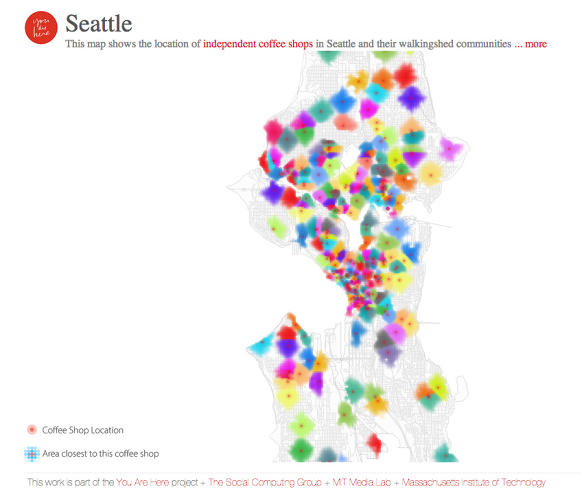The social computing group wants to initiate social change via data visualisation at the rate of a map a day.

The little things that make an otherwise cramped-and-concrete urban life worthwhile (green space, bike lanes, coffee shops) are exactly what the You Are Here project is about.
Over the next two and a half years, MIT Media Lab professor Sep Kamvar will lead a team of computer scientists, artists, architects, urban planners, designers, and educators to draw 10,000 maps—that’s 100 different cities, rendered 100 times each—in hopes of illuminating the details that make cities great. Or, in some cases, not so great.


“I realised that whenever I look at a map, it just tells me the streets and the buildings, and that’s such a small fraction of what actually makes up a city,” Kamvar says. “I wanted to make some maps to help people understand their cities better.”
From our partners:
Kamvar runs the Social Computing group within MIT Media Lab. Their goal, stated simply, is to leverage technology to help people help themselves. As for what this mission statement has to do with map-making, “Each of these maps may show a different aspect of the city,” Kamvar explains. “People will choose what to do with that information.”
[infobox]”I wanted to make maps to help people understand their cities better.”[/infobox]In the three weeks since the project has started, Kamvar’s lab has released maps of bicycle crashes, trees, and coffee shops, across cities like San Francisco, Cambridge, Seattle, Portland, and Chicago. None of these data sets comes with a specific suggestion from Kamvar’s team, like, “Hey Chicago, you need to add more bike lanes in the Loop because of all the biking accidents there,” but having said that, Kamvar allows that his team is trying to make maps that suggest what people might do.


“As an example, we just did street greenery maps. And that might suggest places where one might plant a tree. It’s very simple,” Kamvar says. “We don’t know yet how to do that with some of the deeper more entrenched problems, but we’ll get there.”
Now simple might be an understatement at any level of the project—for instance, to map the trees on the streets of Atlanta, the team had to first write an algorithm that could decipher trees in Google Street View. Then their software had to drive the city streets, virtually, counting the plants that would eventually be plotted on a map of Atlanta. But Kamvar’s point is well taken. If you want more trees, you simply plant more trees. If you want more coffee shops, you can simply open more coffee shops. Meanwhile, as the project tackles topics like poverty, education, and homicide rates, it will be delving into the darker corners of our urban existence, filled by interconnected socioeconomic policies and realities that lack a quippy one-sentence fix.
“I think by nature, each map can only say so much. And it’s not coming to a definitive conclusion on anything. The whole picture of the city will be given by the 100 maps, and not even by the 100 maps,” Kamvar admits. “I think really the intent is to be the starting point of conversations rather than the conclusion of conversation.”
This article originally appeared in Fast Company.














